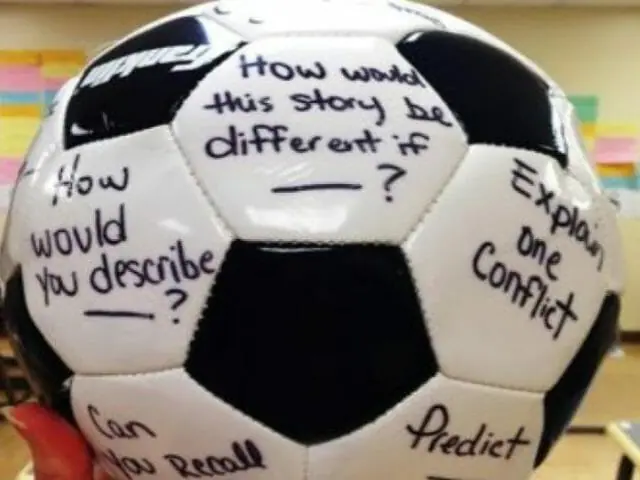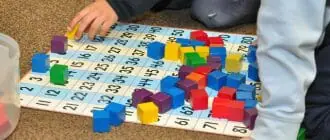Reading comprehension is a critical skill for all students to master. However, it isn’t always the most exciting subject to learn, especially for 7th-grade students who are often already struggling with the material.
That’s why it’s essential to mix up your instruction with some fun and engaging activities! Not only will your students be more interested in the material, but they’ll also be better able to retain what they’ve learned.
For that purpose, here are 11 fun 7th-grade reading comprehension activities and games that you can use in your classroom to liven up your instruction and help your students master the material!
1. Socratic Soccer Ball

Starting off our list is the Socratic Soccer Ball activity, which, as it sounds, involves using a soccer ball to help your students understand and review reading comprehension concepts!
To prepare for this activity, simply write a series of questions related to the material you’re covering on the ball with a permanent marker.
Then, have your students stand in a circle and kick the ball around as they answer the questions.
This is a great way to review key concepts while getting your students up and moving!
2. Anchor Charts

Anchor charts are a staple in many classrooms for a good reason – they’re an incredibly effective way to visually represent and reinforce key concepts in reading passages.
For reading comprehension, consider creating anchor charts on story and literary elements, context clues, and characters.
Not only will your students benefit from having the information displayed in front of them, but they’ll also be able to refer back to the charts as needed.
3. Character Traits and Conflict

Character development is an important part of reading comprehension, and this activity will help your students understand and remember key traits and conflicts.
Students first need to identify the character traits of the different characters in the reading passage.
To do this, they can use index cards to write down each character trait as they notice it. Once they have a list of traits for each character, they can then group similar ones together and see how the character progresses throughout the story.
After doing this, they can then identify the different types of conflict that the characters experience.
Just as with the character traits, they can use index cards to write down each type of conflict and group them accordingly.
Once they’ve completed both tasks, they can then compare and contrast the different character traits and conflicts to see how they impact the story as a whole.
4. Story Element Cards

Also referred to as the Story Mountain, Plot Arc, or Plot Diagram, this activity is a graphic organizer that visually represents the key parts of a story.
To use this activity, simply have your middle school students create their own story element cards for a story they’re reading as part of your lesson plan.
They can include the exposition, rising action, conflict, climax, falling action, and resolution on their cards.
Once they’ve created their cards, they can then use them to order the story’s events and see how they all fit together.
5. Prediction Passages

During seventh-grade reading classes, your students will likely come across a lot of words and figurative language they’re unfamiliar with.
This can make it difficult for them to understand the material, which is why prediction passages can be so helpful.
To use this activity, simply choose a short passage from the story you’re reading and provide your students with a list of the new vocabulary words.
Then, have them read the passage and make predictions about what they think will happen based on the new words.
This is a great way to help your students not only understand the material and boost their comprehension skills but also remember the new vocabulary words.
6. Brian’s Winter Chit-Chat Cards

Brian’s Winter is one of our all-time favorite novels to use with seventh-grade students. In this activity, students get chit-chard cards to encourage them to have discussions about the chapters they’ve read.
This is a great way to get your students engaged in the material and reflect on what they’ve read. It also allows for some fantastic discussions that can help solidify key concepts!
7. Summary Sentences

Reading skills are assessed in various ways, but one common assessment is the summary sentence.
A summary sentence is used to summarize different sections of a passage. These sentences can apply to every text, whether long or short, fiction or nonfiction.
To use this activity, simply have your students choose a section of the story to focus on and write a summary sentence for it.
They can do this for as many sections as they’d like, or you can assign a certain number of sections for them to cover.
This is a great way to wrap up a valuable lesson in reading and make sure your students comprehend the material in a deeper way.
8. Retell, Relate, Reflect, and Review

Retell, relate, reflect, and review is a strategy that can be used with any text. It’s a great way to check for understanding and solidify key concepts.
To use this activity, simply have your students retell the story in their own words, relate it to something else they know about, reflect on what they’ve read, and review what they’ve learned.
This is a great way to wrap up a valuable lesson in reading and make sure your students are comprehending the material in a deeper way.
9. Sticky Notes to Teach Reading Strategies

Sticky notes are among one the most versatile tools in a teacher’s arsenal. You can use them for various purposes, including teaching reading comprehension strategies.
To use this activity, simply choose a strategy you want to focus on (monitoring comprehension, activating prior knowledge, making connections, synthesizing, visualizing, or making inferences) and create a list of questions for your students to answer.
Then, have them use sticky notes to write down their answers.
This is a great way to get your students thinking about the reading strategies and how they can be used. It’s also a great opportunity for them to ask questions and get clarification on anything they’re unsure about.
10. Body Biographies

A character poster is a great way to engage your students and get them thinking about the character in a deeper way. This activity can be used with any character from any book.
To use this activity, have your students choose a character from the story. Then, have them create a poster that includes information about the character’s physical appearance, personality, likes/dislikes, character traits, background information, and any other relevant information.
This is a great way to get your students thinking about the character in a deeper way. It also allows them to make inferences and draw conclusions about the character based on the information they find.
11. Reading Comprehension Worksheets

Last but not least, reading comprehension worksheets are a great way to check for understanding and reinforce key concepts. There are many worksheets available for a variety of levels.
To use this activity, simply choose the 7th-grade reading comprehension worksheets that best fit your needs and assign them to your students. There are reading comprehension worksheets about everything–from nonfiction passages to fiction stories.
Jump In: Check my blog post about another fun activity for your 7th-grade students —11 Free 7th Grade Reading Fluency Passages For Your Class.
Now’s the Time to Boost Your 7th Graders’ Reading Skills!
The results of incorporating just a few of these activities into your reading instruction will be amazing! Your students will become better readers, and they’ll be better prepared for the challenges of seventh grade.
Give them a try and see for yourself!
Last Updated on July 24, 2022 by Emily
- Facebook9
- Twitter21
- Pinterest67
- 97shares




